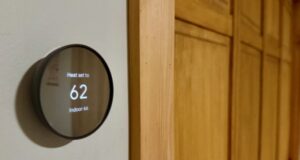
Solar boosted (or hybrid) hot water systems use the sun’s energy to heat water and incorporate a gas or electric booster to ensure consistent hot water delivery regardless of weather or seasonal conditions. These systems offer long-term energy savings and reduced greenhouse gas emissions.
How solar hot water systems work
Solar hot water systems use flat plate collector panels or evacuated tube arrays to absorb solar radiation and heat water. Depending on the system type:
- Water is circulated either naturally (thermosiphon) or via a pump (split system)
- If solar energy isn’t sufficient, a booster (either gas or electric) heats the water to meet demand and hygiene standards (minimum 60°C)
The booster only activates when needed, maintaining energy efficiency.
System types
Thermosiphon systems
- Collectors and tank are both mounted on the roof
- Water circulates passively via gravity
- Can experience greater heat loss from roof-mounted tanks
Split systems
- Collectors on roof, tank on the ground
- Circulation achieved through a low-wattage pump
- Less heat loss and better serviceability
Collector types
- Flat plate panels: Glazed copper tubes under glass that absorb solar energy. Cost-effective and well suited for most Australian climates.
- Evacuated tubes: Copper pipe sealed within vacuum glass tubes to reduce heat loss. More efficient in colder, low-sun environments.
Where solar hybrid systems are used
Solar boosted systems are common throughout Australia, particularly:
- In regions with low winter sun exposure
- In homes wanting to reduce reliance on grid electricity or gas
- Where solar-only systems can’t meet full year-round demand
Is a solar hybrid system right for you?
Benefits:
- Significantly reduced energy bills
- Reduced greenhouse gas emissions
- Eligible for Small-scale Technology Certificates (STCs) and state rebates
- Long-term return on investment
Considerations:
- Higher upfront cost compared to conventional electric/gas systems
- Booster energy use depends on climate and water demand
- Requires adequate roof space and north-facing orientation for optimal performance
Gas boosters are typically more efficient and cost-effective over time compared to electric boosters.
Installation requirements
- Panels must be placed where they receive maximum sunlight, ideally north-facing
- Roof structure must support panel and tank weight (if using thermosiphon system)
- For gas boosters, a connection to the gas supply is required
- Ensure the system is accessible for maintenance and cleaning
- Installation must comply with NCC Volume Three (Plumbing Code) and AS/NZS 3500
Always obtain multiple quotes and check that costs include installation, rebates and compliance.
Suggested diagrams
- Thermosiphon vs split system comparison
- Flat panel vs evacuated tube efficiency graph
- STC rebate eligibility checklist
- Solar boost activation flowchart
Solar hybrid hot water systems are an ideal choice for energy-conscious households looking to reduce environmental impact while ensuring a reliable hot water supply all year round.





